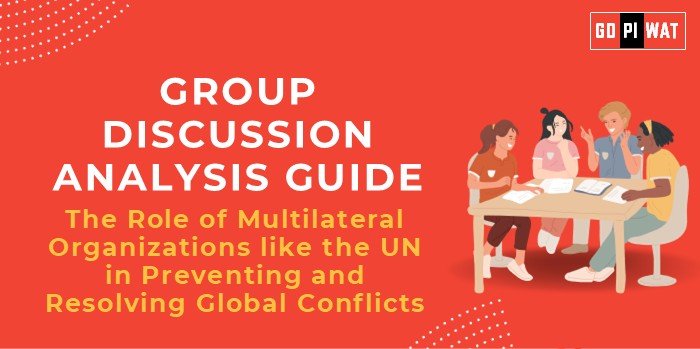📋 Group Discussion (GD) Analysis Guide
🌍 The Role of Multilateral Organizations like the UN in Preventing and Resolving Global Conflicts
🌐 Introduction to the Topic
Opening Context: Multilateral organizations such as the United Nations (UN) serve as cornerstones for international diplomacy, aiming to prevent and resolve global conflicts through collective action, dialogue, and enforcement mechanisms.
Topic Background: Established in 1945 after World War II, the UN has grown to include 193 member states, striving to maintain international peace and security. The organization’s framework includes initiatives like peacekeeping missions, diplomatic mediation, and international sanctions to address conflicts worldwide. Recent challenges include conflicts in Ukraine, Syria, and Sudan.
📊 Quick Facts and Key Statistics
- 🌍 UN Member States: 193, making it the most comprehensive multilateral body globally.
- 🛡️ Peacekeeping Operations: 12 active missions (2024) with over 87,000 personnel deployed.
- ✅ Conflict Resolution Impact: Prevented 50+ conflicts since its inception.
- 💰 Annual Budget: $3 billion for peacekeeping in 2024—significantly lower than global military expenditures.
- 🏠 Global Refugee Count: 108 million displaced by conflict (UNHCR, 2024), reflecting the need for robust conflict prevention.
🤝 Stakeholders and Their Roles
- United Nations: Facilitates negotiations, imposes sanctions, and deploys peacekeeping forces.
- Member States: Provide funding, personnel, and diplomatic support.
- Civil Society Organizations: Advocate for human rights and accountability.
- Regional Alliances: The African Union (AU) and European Union (EU) play complementary roles in peace efforts.
- Conflict-Affected Populations: Central to decision-making but often marginalized in implementation.
🏆 Achievements and Challenges
Achievements
- ✅ Peacekeeping: Stabilized regions like Liberia and Sierra Leone.
- ⚖️ Conflict Resolution: Brokered peace agreements, e.g., the Colombia-FARC accord.
- 📜 Global Sanctions: Successfully curbed nuclear ambitions (e.g., Iran).
Challenges
- ⚠️ Geopolitical Rivalries: Veto power in the Security Council often stymies action.
- 📉 Funding Gaps: Inadequate resources for extensive operations.
- 🔍 Accountability Issues: Limited enforcement of resolutions.
🌍 Global Comparisons
- 👍 Success: Norway’s mediation in Sri Lanka showcased effective third-party diplomacy.
- 👎 Challenges: UNSC paralysis over Ukraine due to power dynamics.
🗣️ Structured Arguments for Discussion
- ✅ Supporting Stance: “The UN has been instrumental in de-escalating conflicts like the Iran-Iraq war through effective mediation.”
- ❌ Opposing Stance: “The inability of the UN to address the Syrian Civil War highlights its limitations in complex geopolitics.”
- ⚖️ Balanced Perspective: “While the UN provides a vital platform for peace, reforms are essential to enhance its efficacy amidst evolving global dynamics.”
🎯 Effective Discussion Approaches
Opening Approaches
- 📜 Quote: “The UN was not created to take humanity to heaven but to save it from hell.” – Dag Hammarskjöld.
- 📈 Fact-based: “The UN’s $3 billion peacekeeping budget contrasts starkly with the $2 trillion global military expenditure.”
Counter-Argument Handling
- ✔️ Highlight UN success stories (e.g., Namibia’s independence) to rebut claims of inefficiency.
📈 Strategic Analysis of Strengths and Weaknesses
- ✨ Strengths: Global legitimacy, diverse membership, peacekeeping expertise.
- ⚠️ Weaknesses: Political gridlock, underfunding, limited enforcement power.
- 🌟 Opportunities: Strengthening regional collaborations, digital conflict monitoring.
- ⚔️ Threats: Escalating nationalism, reliance on major powers.
📚 Connecting with B-School Applications
- 🌍 Real-World Applications: Leadership in conflict resolution can inspire corporate strategies for managing crises.
- 💬 Sample Questions:
- “How can the UN’s conflict resolution model be adapted for organizational conflict?”
- “What leadership qualities emerge from the UN’s success stories?”
Insights for Students: Collaborative approaches are crucial in conflict-prone projects, and effective leadership involves balancing diplomacy with decisive action.


